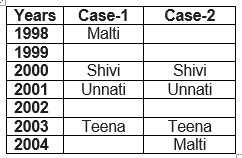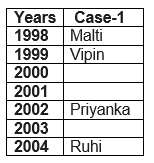Question
Seven persons Priyanka, Malti, Ruhi, Shivi, Teena,
Unnati and Vipin were born on the same date of seven different years viz. 1998, 1999, 2000, 2001, 2002, 2003 and 2004 but not necessarily in same order. Who is the oldest among them? Statement I: Two people were born in between Unnati and Malti. Teena was born in 2003. Only one person was born between Unnati and Teena. Shivi was born immediately before Unnati. Statement II: Four people were born between Vipin and Ruhi. Priyanka was born two years before the leap year but not in 1998. Vipin was born immediately after Malti. Three people were born between Malti and Priyanka. The question given below consists of two statements numbered I and II given below it. You have to decide whether the data provided in the statements are sufficient to answer the question. Read all the statements and give answer.Solution
Given that Seven people Priyanka, Malti, Ruhi, Shivi, Teena, Unnati and Vipin were born on the same date of seven different year’s viz. 1998, 1999, 2000, 2001, 2002, 2003 and 2004. From statement I: Two people were born in between Unnati and Malti. Teena was born in 2003. Only one person was born between Unnati and Teena. Shivi was born immediately before Unnati. So, we have two cases i.e., we do not have proper information so statement I alone is not sufficient to answer.  From statement II: Four people were born between Vipin and Ruhi. Priyanka was born two years before the leap year but not in 1998. Vipin was born immediately after Malti. Three people were born between Malti and Priyanka. So, we have
From statement II: Four people were born between Vipin and Ruhi. Priyanka was born two years before the leap year but not in 1998. Vipin was born immediately after Malti. Three people were born between Malti and Priyanka. So, we have 
In ETL pipelines, which step is primarily responsible for resolving inconsistencies and correcting data quality issues (e.g., missing values, inconsiste...
Which of the following stores historical data for analysis?
Which of the following is a key process in ETL?
In the context of a relational database, which of the following is NOT a characteristic of a candidate key ?
Which SQL clause is used to filter records after aggregation?
A snowflake schema is different from a star schema because:
What does "drill-down" operation in OLAP do?
Which of the following is a real-time data warehouse application?
Surrogate keys are used in data warehouses because:
ETL stands for:
Relevant for Exams:



